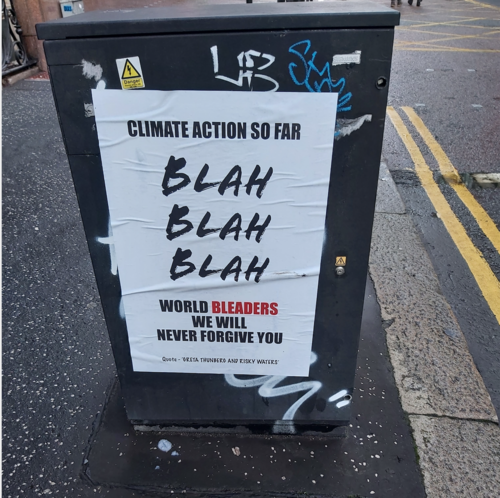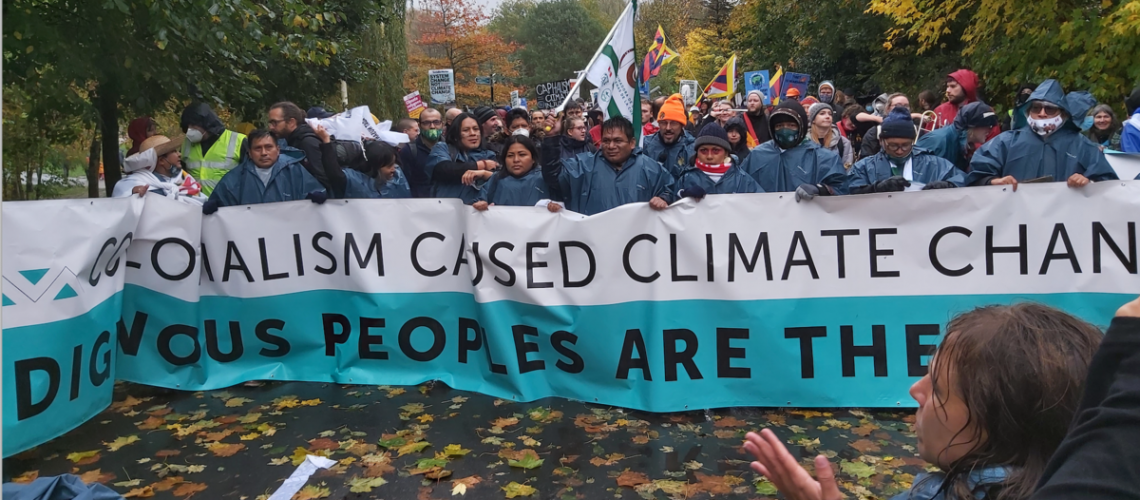The United Nation’s 26th Climate Conference (COP26) – “our best last chance on climate” – is over. We were promised increased ambition, more cash for those most affected by climate change, and movement towards the Paris Climate Agreement’s aim of keeping global heating to 1.5 degrees.
So what did we get, and how does a COP work?
How does a COP work?
Each year, a different country hosts the United Nations Framework Convention on Climate Change (UNFCCC) Conference of the Parties (COP). The Parties are the signatories of the UNFCCC and include 196 countries and the EU. The host country has to set up a zone for people registered with the UNFCCC. This year it was called the Blue Zone and you could get accredited in advance if you were part of a national delegation, the UN, the media or a non-profit observer organisation. There was also a Green Zone for the general public.
Because of a lack of affordable accommodation and passes for activist groups who had travelled from around the world, this year’s COP was called “the most exclusionary ever”.
These concerns were compounded by the revelation that the largest number of accredited people came from the fossil fuel industry – 500+ (more than any one country). The nuclear lobby also had a big presence, both at their own stall and on the Russian Pavilion. The Green Zone was jokingly referred to as the ‘Greenwash’ zone, given it was supported by the likes of Unilever, Sky, Microsoft and pharmaceutical giant GSK.
Further sources of unease included the long, non-Covid-safe queues to get into the Blue Zone; the refusal to allow those with Observer passes into the first two “World Leader Days”; and closing controversial events to observers like “Unlocking Net Zero through investment in sustainable bioenergy and BECCS [Bioenergy Carbon Capture and Storage],”. Many concluded that the organisers didn’t want people interacting with speakers from Drax (the UK’s most polluting company) and Enviva (one of the world’s largest destroyers of forests).

In the New Yorker, the veteran environmentalist and author Bill McKibben summed up the feelings of many: “Young activists are right to doubt the pledges of governments, financial firms, and the fossil-fuel industry.”
What did we get?
On forests
Forests were everywhere at COP26, from Nature Based Solutions (NBS) stalls to Pakistan’s 10 billion tree tsunami project, leading some to dub this the ‘Nature COP’. World leaders, financial institutions and companies united on global goals to both halt deforestation and cut methane emissions, pledging more than US$20 billion in finance. But will this accelerate a transition toward a low carbon, nature-positive and climate-resilient future?
The Glasgow Leaders’ Declaration on Forests and Land Use was billed as COP26’s first big success, reaching 137 signatory countries before the COP was over. But the mood music soon changed, as analysts realised it did not stand up to scrutiny. Not only is it a rehash of previous unfulfilled commitments, but its promise to halt and reverse forest loss and land degradation by 2030 was so out of step with what needs to happen that it led to a viral article about a man planning to give up drinking alcohol by 2050. Earthsight highlighted just one example of the vast gap between words and action, pointing out that Paraguay – who signed the Declaration– has submitted a Nationally Determined Contributions (NDC) plan which foresees its already huge deforestation rate rising even higher.
But that is not the only concern: the UK’s Daily Telegraph, whose opinion pages have long provided a refuge for climate change deniers, rightly took exception to the Declaration because: “Britain will continue to produce electricity from burning the equivalent of more than 25 million trees a year… [Boris Johnson] has been accused of ‘conveniently ignoring’ the alleged harm to forests done by Drax biomass power station, which burns fuel pellets made from processed wood.”
Increased funding for Forest Governance, Markets and Climate programme (FGMC) – On behalf of the UK government, Lord Goldsmith announced that funding for FGMC will be doubled and continue for at least another 10 years. This is one of the few funds aimed at improving forest governance, so activists hope that this focus will remain. The announcement came at the Indonesia Pavilion, where much was made of the fact that deforestation is falling in the country – although nothing was said about it still rising in areas where forests remain (such as West Papua). The announcement was followed by the UK Timber Trade Federation launching the Tropical Timber Accord, which proposes a new governance approach for the global tropical forest sector based on national standards within an international framework. It is positive that the private sector is coming together to advocate for greater global governance and enforceable legal frameworks, but it remains to be seen what actual change on the ground will look like.
The Central African Forest Initiative (CAFI) – President Félix Tshisekedi of the Democratic Republic of Congo (DRC) and UK Prime Minister Boris Johnson announced a 10-year agreement (2021-31) to protect the country’s rainforest – part of the world’s second largest – stating: “With its forests, water and mineral resources, the Democratic Republic of Congo is a genuine ‘Solution Country’ to the climate crisis. To protect our forest and promote its sustainable management, our priority, backed by this new partnership, is to strengthen governance and transparency across all land use sectors.” The initiative is considered a mixed bag of positive moves towards improving forest governance, and halting large scale forest conversion, while continuing almost business as usual on extractives. There was also concern that Objective 11: “A national population policy”, could easily lead to the government interfering in women’s reproductive rights and Congolese people’s family choices.
The Forest, Agriculture & Commodity Trade (FACT) Dialogue: This was the UK Presidency’s main mechanism for ensuring inter-governmental dialogue in the run-up to the COP, but it yielded a fairly vague roadmap full of commitments to ‘explore options’ and ‘map’ how to protect forests. This is not surprising given the tight timeline within which the dialogue happened. The most promising aspect of these dialogues is the diverse range of governments they were able to bring together. The question is whether these dialogues will continue to enjoy such varied participation, and whether they succeed in promoting greater cooperation after COP26.
The Agricultural Commodity Companies Corporate Statement of purpose: In parallel, 12 companies representing a significant share of the global trade in forest-risk commodities pledged to halt forest loss by 2030. Any excitement this caused soon fell flat, considering the wealth of statements and declarations that have preceded it, to no avail. For example, a number of these companies had already pledged (and failed) to eliminate deforestation from their supply chains by 2020.
The Powering Past Coal Alliance (PPCA) made some steps towards their stated aim of “consigning coal to history”, but it was massively undermined by the refusal of the US, China, India and Australia to sign the pact. In addition, there was no space to discuss what was meant by the “clean, affordable and reliable energy” that would replace it. For example, the EU stood firm on its commitment to continue to replace coal with forest destroying bioenergy, despite the demands of climate and conservation leaders.
On Indigenous Peoples’ rights
Rights and Resources and others used the COP to release new research revealing that 958 million hectares (mha) of Indigenous and community territories contain over 250 billion metric tonnes of carbon. However, these communities only have legally recognised rights to less than half of this area. Thanks to the efforts of supportive organisations from around the world, Indigenous representatives were very visible at the COP, but we are yet to see whether their role in protecting the world from the climate crisis will be well supported. Hopeful signs came from the historic pledge that $1.7 billion will be given directly to Indigenous People and local communities to help them protect forests – an announcement the Guardians of the Forest welcomed. However, given the crucial role of Indigenous Peoples in protecting the world’s forests, concerns remain that their rights are not explicitly recognised in the rest of the funding pledges.
On financing
The Glasgow Leaders’ Declaration on Forests and Land Use announcement was followed by a spree of funding pledges. The key questions though, are whether the money will materialise, how it will be spent and who will be making such decisions.
Carbon Trading (and Article 6): Scientists and activists were particularly concerned by the outcomes on carbon trading rules. Offering a get-out-clause to countries whereby they can pay to continue emitting, could eliminate any remaining chance to get the world on a pathway to 1.5C. More positively, however, there was a push for a non-market mechanism through Article 6.8, which urges Parties to implement joint mitigation and adaptation measures, technology transfer and capacity building. There was also text that incorporates human rights, including the rights of Indigenous Peoples, although it is weak and fails to refer to essential international standards such as the right to free, prior and informed consent. Another huge concern was that countries will be able to use flawed emissions reductions credits dating back to 2013, from the widely discredited Clean Development Mechanism (CDM). The only positive outcome from the carbon trading discussions would have been an end to carbon markets and offsets, which delay the just transition to a low-carbon economy.
Global Forest Finance Pledge (GFFP):Despite not fulfilling previous promises, countries pledged overseas development assistance of US$12 billion for forest-related climate finance between 2021-2025. While this is a broadly positive development, the Presidency’s attention so far has been entirely focused on getting the announcement over the line, meaning crucial questions such as how the money will be spent and who will have a say in allocating these funds remain unanswered. NGOs are concerned with the continued opacity of climate finance and are calling for greater scrutiny on its impact on local communities and forests’ resilience. European Commission President Ursula von der Leyen announced that €1 billion of this fund would come from the EU to help partner countries protect, restore and sustainably manage forests worldwide. While this is broadly positive, the crucial questions of how the money will be spent and who will have a say in defining this, remain unanswered. It seems likely that the money pledged by the EU (for example) will not be new and may go to already concerning conservation schemes like NaturAfrica.
Congo Basin Joint Donor Statement: At least US$1.5 billion of financing from 2021-2025 was agreed to protect and maintain the Congo Basin forests, peatlands and other critical carbon stores. The money is to come from the EU, Germany, France, Japan, Belgium, Netherlands, Norway, Sweden, Korea, UK, US and the Bezos Earth Fund. The announcement is a welcome recognition of the Congo Basin forests carbon sequestration potential. However, the human and not only climate value of these forests is at stake. Their protection should not be a smokescreen for lowering the guard on emission at the expense of the 80 million people who depend on these forests for their livelihoods. It is also important to learn from previous mistakes made by conservation organisations.
The Multilateral Development Banks Joint Statement for Nature, People and Planet: The banks committed to mainstreaming nature across operations; leadership; being nature positive; fostering synergies; valuing nature to guide decision making; and reporting. They will set out the strategic approach to doing this by 2025. Until then it is difficult to know what changes this will actually lead to in terms of their lending portfolio.
Climate Funding: The much talked about US$100 billion for the Global South is now unlikely to materialise until 2023 or 2024. Harjeet Singh, a senior advisor at Climate Action Network International (CAN), said: “It is our moral responsibility to help developing countries so that they can adapt.” He cited estimates that the cost of climate impacts on developing countries could rise to between $290bn and $580bn by 2030. “The less we do on mitigation, the more we have to invest in adaptation,” he said. It is essential that any climate finance is given and spent transparently, otherwise it can increase emissions and generate wide environmental and social damage for vulnerable communities. A recent report funded by Transparency International and Fern – Climate finance – how can it help to protect forests and human rights and improve governance explains why it is important for policy makers and donors to scale up funding that genuinely goes to forests and their protectors.
So are we doomed?
With trust in politicians at an all-time low, it is hard to know how to feel after the roller-coaster of another COP. Discussions inside the meeting were dismissed as “blah blah blah” and were sometimes dangerously optimistic – such as when the International Energy Agency (IEA) tried to make a “hypothetical” future of 1.8 degrees temperature rise something to celebrate (before being quickly reminded that the more likely true figure is 2.7 degrees).
The Observer newspaper certainly made things sound worrying, asking “Where should I move to in order to best survive the climate crisis?” And even small positive steps such as the agreement on methane could be hard to implement, given the hesitance shown by the powerful Brazilian beef industry.
But if there is hope, it is to be found on the streets of Glasgow, and in the refusal of so many climate activists to accept business as usual. There is also hope in the increased role and funding for Indigenous Peoples and Local Communities; in Greta Thunberg’s insistence on raising the voices of activists from Tibet to Kenya who are already seeing their lives and livelihoods destroyed; in countries such as Costa Rica and Denmark pushing for real change and an end to the fossil fuel industry; and in the 1000s of side meetings where civil society came together to push even harder for real action, and for constructive ways to keep the oil and forests in the soil.
But hope won’t save the world, and nor will vague net zero commitments which climate scientist Kevin Anderson calls “Latin for kicking the can down the road. It’s passing the burden on to the next generation.” And we don’t seem to be going in the right direction, as Politico’s Karl Mathieson said: “The rumbles in the corridors at the COP26 climate talks have been growing all week: Where is the EU? …according to green groups, diplomats, observers and allies, the EU in Glasgow has appeared ineffective, constrained and at times looked inept.”
It is time for the EU to turn this around, to reinvigorate its innovative Forest Law Enforcement, Governance and Trade (FLEGT) programme, to come up with a strong deforestation law to end the EU’s vast forest footprint, and to stop supporting the false climate solution of burning wood for energy.
Source : www.fern.org






